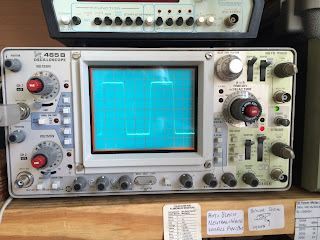As a part of a project to build a simple shortwave broadcast radio based on the published KD1JV design
Steve KD1JDV Shortwave Broadcast Rx the opportunity was taken to perform some measurements of the 'simple' AM envelope detector circuit. Through this exercise I hoped to gain some practical insights into the behavior of diode detectors.
It is clear from my own observations and from reading the literature on the 'simple' diode detector that it is by no means 'simple'! The more one explores and understands the more complex it appeared to me. Especially with respect to the subject of introduced distortion to the input complex modulating waveform.
The detector used was a Schottky SD101A diode that was biased to approximately 60uA. The spec sheet
Schottky diode SD101A shows an ON resistance of approximately 200 ohms at this quescient point. It also shows a voltage input swing of approximately 200mVp-p before the diode would turn off or before the 1mA 'knee' would be reached.
The test fixture and measurement results are shown
here
A view of the carrier ripple across the diode output is shown
here
Some observations as follows:
- With an input 455KHz carrier (this Rx IF frequency) the measured carrier ripple current was 50mVp-p on the diode output. This seems to be insufficient carrier smoothing since once this RF is amplified by the audio amp it appears on the speaker output at an amplitude of approximately 400mV. Will this be a problem in the final receiver. Can the values of these two .001uF capacitors be increased without causing distortion to the modulating audio signal? TBD.
- The carrier was modulated with a 1KHz tone and a 400Hz tone and Music (Santana) for varying levels of AM modulation from about 8% to 90%. No major distortion was detectable by my ear and when listening to the output with a pair of iphone earbuds.
- The carrier frequency was varied from 100KHz through to 50MHz with no real noticeable difference in music quality output.
- As the carrier frequency was increased of course the carrier ripple became so small as to be un-measurable.
- The audio amp voltage gain = 20. Quiet room volume level needed an output signal of about 4Vp-p into 8 ohms. This equates to a 200mV input signal needed into the audio amp. Tests were conducted up to 380mVp-p input to the detector before distortion was noted on the input signal. Looking at the diode specs suggests that distortion will occur with an input signal greater than 200mVp-p.
- Varying the bias level by adjusting the 100K potentiometer in the bias supply did not make a noticeable difference to the audio output waveform.










